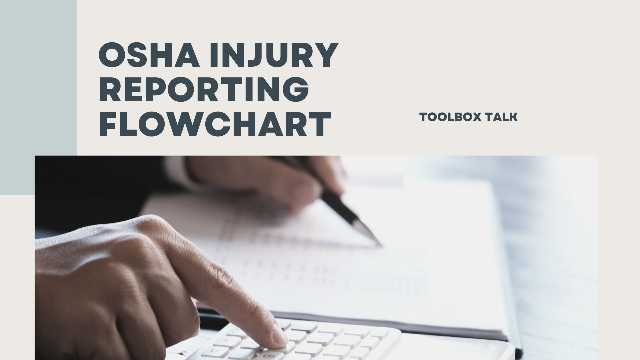OSHA injury reporting flowchart: toolbox talks we are not going to talk about minor injuries. You know that all cases of recordable injuries must be reported. The injured person should go to the infirmary for immediate first aid, no matter how serious or insignificant the injury may seem. It should be noted that in such cases no one should assume the role of doctor as the injury could be aggravated by infection or wrong treatment.
OSHA require record-keeping and reporting of the injuries at the site. But you must know which types of injuries are recordable and reportable. You can download an OSHA injury reporting flowchart in form of a pdf in the last of this toolbox talk.
Reporting through OSHA injury reporting flowchart
A quick way to find out if an incident is recordable is through an OSHA recordable decision checklist.
- Was the employee absent from work?
- Did the employee need a job transfer?
- Does the employee require a work restriction?
- Did the employee suffer a loss of consciousness?
- Did the employee require medical treatment other than first aid?
- Has the employee received a diagnosis of a serious or significant work-related disorder?
- Has the employee suffered a needlestick or stab wound with a contaminated object?
- If the answer to any of these questions is yes, you must record the incident.
What should you do first if an incident occurs?
In most cases, the same rule applies – refrain from treating the victim and notify the responsible persons so that someone experienced in first aid can take charge of the situation. You have to restrain yourself and avoid moving the victim without trying to help her/his since any movement would probably aggravate his condition.
Of course, there are cases where the important thing is to act quickly. If the worker was caught by a machine immediately. If you can't do it and the person is at great risk, try to get him out of the trap, but be very careful so that the machine doesn't catch you too.
If the victim is in contact with a live electrical wire and cannot be freed, remove power from the circuit if you can. If that's not possible, don't try to be the hero by pulling the victim, as chances are you'll get electrocuted too. If you have a wooden stick handy, you may be able to peel it off, being careful not to touch anything with your hands or body.
Or, if you know how to do it, you could spread something dry like a newspaper on the floor and wrap your hands with paper to loosen it. The important thing is to remember that you should not touch the person who is in contact with electricity unless the person trying to help is sure that you will not take a risk. Electrocution is unfortunate but, much worse.
There are following two kinds of injuries that require immediate treatment even before calling for help. If you know how to treat them, start doing it right away, sending someone to bring help.
- In the first case, the victim stopped breathing. His life will depend on someone giving him artificial respiration immediately. If you know how to do it, start giving it right away and keep doing it until the doctor tells you the person is dead or you notice the person starting to stiffen.
- The other case is a haemorrhage. In this case too, if you know how to stop the bleeding, do it right away.
Your immediate action is required if
If a worker's clothing catches fire, drop him to the ground (push or stumble, if necessary) and roll them. If you have a heavy blanket, try wrapping it around him to smother the flames. But if you don't have anything handy, roll it on the floor.
If a worker is splashed with an acid or caustic substance, the affected part should be rinsed with plenty of water, with a hose or in a shower.
If medical personnel are late in arriving, try to calm the person by keeping them warm and keeping their heads lower than the rest of their bodies. But remember, if you have to choose between moving the patient and risking further injury, it's best to leave the patient alone until the doctor or nurse arrives.
Finally, it is convenient to know what should be done in another kind of accident. I mean the fires in the plant. Many incipient fires have turned into a conflagration because those present did not know how to stop them in time. Therefore, if you discover a fire, in the plant or the house, remember the following:
First: Warn people in danger to make sure they are safe.
Second: From the fire alarm signal (Supervisor: indicate the procedure to be followed in your plant).
Third: After completing the other two, try to extinguish the fire with fire extinguishers or other equipment if you can do so safely and know how to use such equipment.
OSHA recordable Injuries and Illnesses
Another good news is that a 10.7 per cent decrease in fatal work injuries was recorded between 2019 and 2020. The decline in work-related injury and illness cases was due to a drop in injury cases as reported by industry employers.
OSHA requires employers with more than ten employees to keep a record and report serious work-related injuries and illnesses. This information helps employers, employees, and OSHA to assess workplace safety and health, understand industry hazards, and effectively implement worker protections to prevent future workplace injuries and illness.
For more health and safety-related topics, visit: Safety Zone
Related toolbox

.jpg)
.jpg)

